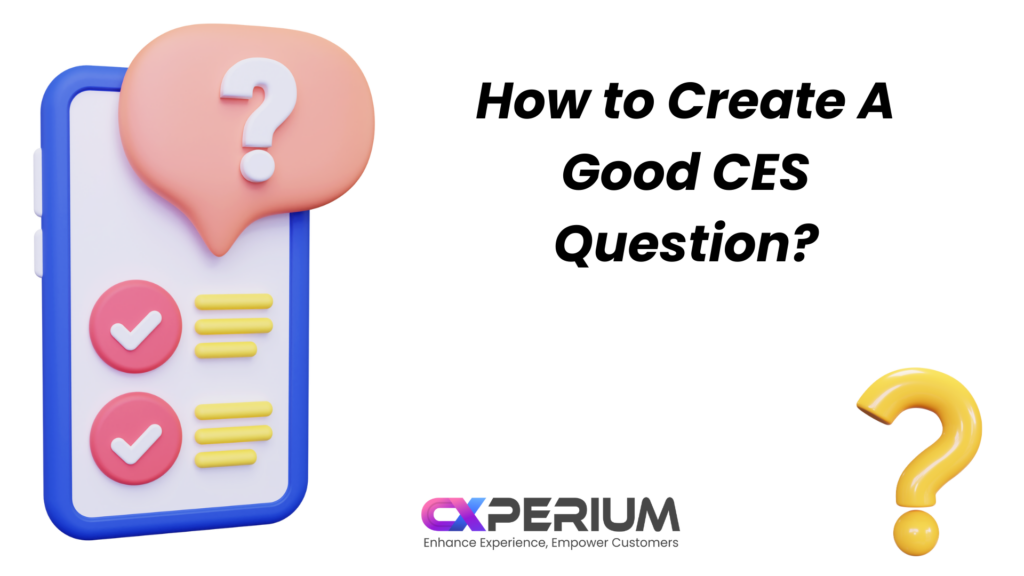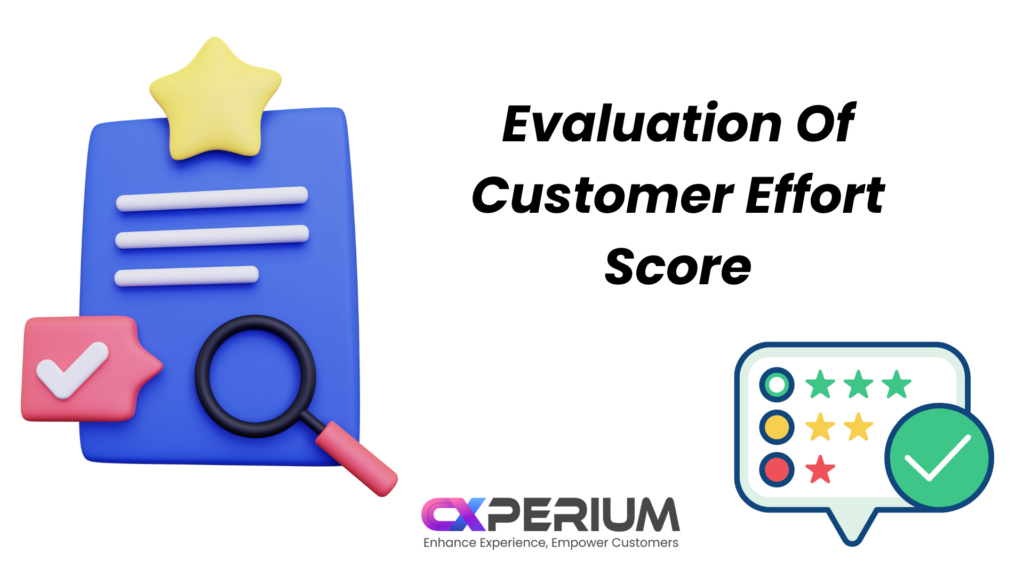What is Customer Effort Score (CES): A Comprehensive Guide

What is the Customer Effort Score?
Customer Effort Score (CES) is a customer satisfaction metric that measures the level of effort a customer has to exert in order to interact with a company or use its product or service. It is a measure of the ease of the customer experience.
The CES survey typically asks the customer to rate how much effort they had to put into resolving their issue or completing a task, such as placing an order or getting a question answered. The customer rate their level of effort on a scale from 1 to 5 or 1 to 7. 1 means very easy and 7 means very difficult.
The idea behind CES is that the less effort a customer has to put in, the more satisfied they will be with their experience, and the more likely they are to become loyal customers. Companies can use CES as a metric to identify areas where they need to reduce customer effort and improve the customer experience. By doing so, they can increase customer satisfaction and loyalty, which can ultimately lead to increased revenue and profits.

CES Surveys
Customer Effort Score (CES) surveys are a type of customer satisfaction survey that measure the amount of effort a customer has to put in to interact with a company or use its products or services. The surveys typically ask customers to rate their level of effort on a scale, such as from 1 to 5 or 1 to 7. If customers rate it 1, that means very easy and 7 means very hard.
The goal of CES surveys is to identify areas where customers are experiencing high levels of effort or friction, which can lead to dissatisfaction and churn. By reducing customer effort, companies can improve the customer experience and increase customer loyalty.
CES surveys are often sent immediately after a customer interaction, such as after making a purchase, resolving an issue with customer service, or completing a task on a website or app. The survey can be delivered through various channels, such as email, SMS, or in-app messaging.
CES surveys are a valuable tool for companies to measure and improve customer satisfaction, as they provide specific and actionable feedback on the customer experience.
Why is it valuable?
Timing: CES surveys should be sent immediately after a customer interacts with your company or uses your product or service. This ensures that their experience is still fresh in their minds and that their feedback is accurate.
Format: CES surveys are typically short and straightforward, with just one question asking customers to rate their level of effort. However, some companies may include additional questions to gather more information about the customer experience.
Scale: The CES scale typically ranges from 1 to 5 or 1 to 7, with 1 being very easy and 7 being very difficult. Some companies may use a different scale. The important thing is to use a consistent scale so that results can be compared over time.
Delivery: CES surveys can be delivered in a variety of ways, including email, SMS, or in-app messages. The delivery method should be convenient for the customer and easy to respond to.
Analysis: Once you collect the CES surveys , you should analyze the results to identify trends and areas for improvement. Companies can use this feedback to make changes to their processes or product/service offerings that will reduce customer effort and improve the customer experience.
By using CES surveys, companies can gain valuable insights into their customers’ experiences and make data-driven decisions. With this, they improve customer satisfaction and loyalty.

How to Create A Good CES Question?
In order to create a good Customer Effort Score (CES) survey question:
Identify the specific customer interaction or task
The first step in creating a good CES question is to identify the specific interaction or task that you want to measure. This could be a recent purchase, a customer service interaction, or any other touchpoint in the customer journey.
Determine the right phrasing
Your CES question should be clear and easy to understand, so that customers can quickly provide their feedback. It should also focus on effort specifically. Here’s an example: “How much effort did you have to put forth to complete [task/interaction]?”
Choose a rating scale
The rating scale should be clear and consistent, with 1 being very easy and 5 or 7 being very difficult. The scale you choose may depend on the type of interaction you’re measuring and the level of granularity you need in your data.
Avoid bias
The question should be neutral and not lead the customer to provide a certain response. Biased questions can lead to inaccurate results.
Consider follow-up questions
While a single CES question can provide valuable feedback, it can be helpful to ask follow-up questions to gain more insight into the customer experience. Open-ended questions are particularly useful for gathering qualitative feedback.
Test the question
Before sending out your survey, it’s a good idea to test the question with a small group of customers to ensure that it’s clear and easy to understand.
By following these steps, you can create a good CES survey question that will provide valuable feedback to improve the customer experience and reduce customer effort.

Evaluation Of CES
Certainly, here are some steps to follow when evaluating Customer Effort Score (CES) results:
Calculate the overall CES score
The first step in evaluating CES results is to calculate the overall score by averaging the responses from all the survey participants. This will give you a general idea of the level of effort customers are experiencing.
Analyze the distribution of responses
Look at the distribution of responses to see if they are skewed towards one end of the scale. If most customers responded with a high score, it may indicate that there are significant issues that need to be addressed.
Segment the data
To gain more insight into specific areas of the customer journey, segment the data by different customer groups, such as demographic information or types of interactions. This will help you identify areas where certain groups are experiencing more effort than others.
Compare to industry benchmarks
It can be helpful to compare your CES score to industry benchmarks to see how your company compares to others in your industry. This can provide context for your results and help you identify areas where you may need to improve.
Analyze open-ended feedback
If you included open-ended questions in your survey, take the time to analyze the feedback to gain more qualitative insights into the customer experience. Look for common themes or issues that may require attention.
Take action
Finally, use the results of your CES survey to take action and improve the customer experience. Identify areas where you can reduce customer effort and implement changes to make the process easier for customers.

Calculation of CES
The calculation of Customer Effort Score (CES) results is straightforward. The CES survey typically asks a single question: “How much effort did you have to put forth to complete [task/interaction]?”
Customers are asked to rate their effort on a scale of 1 to 5 or 1 to 7, with 1 being “very easy” and 5 or 7 being “very difficult”.
To calculate the overall CES score, you simply take the average of all the responses. For example, if you receive 100 survey responses and the average rating is 3.5, then your CES score is 3.5.
The goal of the CES survey is to measure the level of effort required by customers to complete a specific task or interaction. The lower the CES score, the easier it is for customers to complete the task and the better the overall customer experience.
While the CES score is a useful metric for measuring customer effort, it is important to also analyze the qualitative feedback provided in the survey to gain deeper insights into the customer experience and identify specific areas for improvement.

What Are The Advantages and Disadvantages of CES?
Advantages
Simple and easy to understand
The CES survey question is straightforward and easy for customers to understand, which can lead to high response rates and provide valuable insights into the customer experience.
Focuses on customer effort
The CES survey question specifically measures customer effort, which is a key driver of customer loyalty and satisfaction.
Provides actionable feedback
The CES survey can provide specific insights into areas where customers are experiencing high levels of effort, making it easier for businesses to identify areas for improvement and take action to reduce customer effort.
Can be used in a variety of industries
We can use CES surveys in a variety of industries and for different types of interactions, making it a versatile metric for evaluating the customer experience.
Disadvantages
Limited scope
The CES survey question only measures one aspect of the customer experience, and may not capture the full picture of customer satisfaction or loyalty.
Potential for bias
There are many factors can influence CES such as the customer’s mood or current circumstances, which can lead to biased responses and inaccurate results.
May not be relevant for all industries
The CES survey question may not be as relevant for certain industries, such as those that are highly regulated or where customer effort is not a significant factor.
Does not provide context
The CES survey question does not provide context for the customer’s response, such as why they found a particular interaction to be difficult or easy.
Overall, the Customer Effort Score can be a useful metric for evaluating the customer experience, but it is important to consider its limitations and use it in conjunction with other metrics and qualitative feedback to gain a more complete picture of the customer experience.

Use Cxperium To Create High Quality CES Surveys
Do you want to improve your customer experience and drive more loyalty? Cxperium is the perfect tool for you! Our web app allows you to create surveys on messaging apps that measure Customer Effort Score (CES), a crucial metric for evaluating the customer experience.
With Cxperium, you can create different kinds of surveys, such as post-purchase surveys, customer service surveys, and product feedback surveys. Our surveys are specifically designed to measure customer effort, which is a key driver of customer loyalty and satisfaction. By measuring CES with Cxperium , you can identify areas where customers are experiencing high levels of effort and take action to reduce friction and improve the overall customer experience.
But that’s not all – with Cxperium , you can also communicate directly with survey participants and gain even more insights into their experience. Our messaging integration allows you to engage with customers in real-time, gather feedback, and respond to inquiries. This not only improves the customer experience but also strengthens the relationship between your business and your customers.
In today’s competitive market, it’s more important than ever to understand your customers and provide exceptional experiences. With Cxperium, you can gather insights, improve your customer experience, and drive loyalty. Try Cxperium today and see how easy it is to measure customer effort and improve your customer experience!